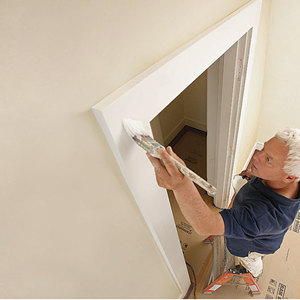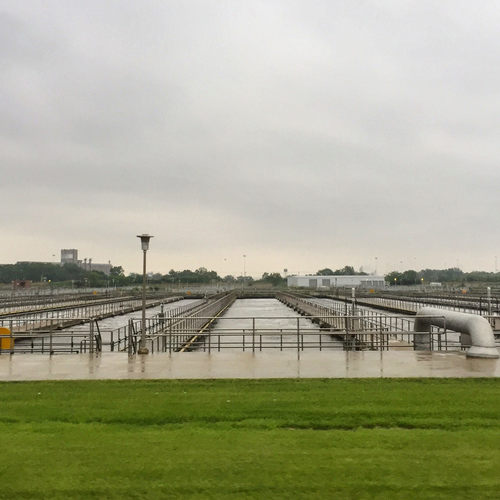
Lately, developments in climate mitigation have often come from the labs of paint manufacturers. From high-tech coatings that scrub the air to coatings that will clean themselves or produce solar power, soon you’ll use your roller to do more than add color. Here’s a primer on recent developments in high-tech paint.
Air-cleaning paint
Air pollution remains a vexing health hazard difficult to control. Chemicals from vehicle exhaust and other commercial sources fill the lungs and leach into our bloodstream, causing illness. Enter Airlite paint of Milan, Italy. This manufacturer developed a coating that purifies air by neutralizing contaminates through a photochemical reaction. The company explains that their product generates a “concentration of electrons” that interact with oxygen and airborne water vapor. These electrons generate negative ions that attach to common pollutants. The negative charge causes the particles of pollutants to cling to positively charged surfaces such as walls coated with Airlite paint.
The company tested their material inside the Umberto Tunnel in Rome. This passageway offers a shortcut from the beautiful Piazza di Spagna to Via Nazionale. Built to alleviate traffic, the tunnel soon became one of the most polluted places in the capital. In a demonstration, Airlite coated the tunnel about ten years ago. The company says the tunnel is still white (clean), without any maintenance, and tests by La Sapienza University of Rome have shown a reduction of pollutants inside the tunnel approaching 51%.
Closer to home, manufacturers have developed coatings that promise to purify household air. Sherwin Williams’s SuperPaint comes with an air-purifying technology that, the company says, contributes to better indoor air quality by reducing volatile organic compound (VOC) levels from potential sources like carpet, cabinets, and fabrics. I looked and looked but could not find an explanation on how the paint sequesters or neutralizes…
Weekly Newsletter
Get building science and energy efficiency advice, plus special offers, in your inbox.

This article is only available to GBA Prime Members
Sign up for a free trial and get instant access to this article as well as GBA’s complete library of premium articles and construction details.
Start Free TrialAlready a member? Log in














12 Comments
The description of the ultra-white paint is technically incorrect. The emission of thermal IR (far IR) is not a reflection process. It is thermal emission, the same process by which a person standing near a hot wood stove is warmed by radiation coming off that surface, but working with lower temperatures. The paint is radiating to the sky because the sky is colder than it is. This is the same phenomenon that was mischaracterized by the same author in another recent article.
Charlie, if you scroll down the comments I found an expert to flesh out the physics of the two systems, the white paint, and the solar cooling. Thanks for your comments as they provoked me to dig a bit deeper and find the correct information.
Dear Charlie, the point of the article is to say many exciting, new developments are coming with paint. The specific sentence you refer to says, "It reflects 98% of solar radiation while outputting (reflecting) heat-generating infrared rays." I admit this statement is not clear. The reflection of infrared rays prevents the painted surface from absorbing this frequency and heating up. People understand reflection and not so easily the word emittance. Writers try to use simple language for understanding, even if technically inaccurate. I don’t pretend to write scientific papers. But following up on your comments on the article about solar cooling, I wrote to the developers of the product described in the article asking them to respond to your observations. Unfortunately, they did not reply to my email or call. I tried. Here too, I just wrote to Dr. Ruan, developer of the super-white paint, asking about the sentence you critique. If he replies, I will post his comments. Your observations are always welcome, and if I can respond with good information, I always will. In this case, the Purdue University press release about the paint says it “repels infrared heat from a surface and reflects up to 98.1% of sunlight.” Repel or reflect? To the layman – like me – this is a very subtle distinction.
Thanks for your reply. The more detailed sentence from the press release (https://www.purdue.edu/newsroom/releases/2021/Q3/purdue-record-for-the-whitest-paint-appears-in-latest-edition-of-guinness-world-records.html) says,
"The formulation that Ruan’s lab created reflects 98.1% of solar radiation at the same time as emitting infrared heat. Because the paint absorbs less heat from the sun than it emits, a surface coated with this paint is cooled below the surrounding temperature without consuming power."
That describes two things: 1. Reflecting solar radiation, and 2. emitting infrared heat. I think you might be misunderstanding that as talking about 1. reflecting visible sunlight and 2. reflecting infrared energy from the sun. In fact the 98.1% of solar radiation that it reflects includes the visible and IR light from the sun. Number 2 is a different phenomenon. Stopping incoming solar radiation, whether it's by reflecting it, repelling it, or locating the house in the shade of a big oak tree, can never cool a surface below ambient. That's why that second process is necessary to achieve cooing below the ambient temperature. It's OK if you don't understand that second process and can't describe it in technical detail, but it's a mistake to describe it as part of the first feature--the reflection of solar radiation.
I'm not finding the "repel" language in the Purdue Press Release. Perhaps you have a different version?
If you want help understanding heat transfer as you prepare any future articles, feel free to contact me. Kiley has my email.
I'd be happy to, Charlie. I try to get the technical stuff right -- although physics requires a level of education I d don't have. I appreciate the help and will take you up on it.
Looking forward to it!
Purdue University has a podcast on the development of ultra-white paint that offers an in-depth description of how the paint works and what it took to invent it.: https://youtu.be/BHyC2cwgkSA. Professor Ruan does distinguish the reflection of solar rays and emittance. It's subtle.
I am curious about the impact the ultra-white paint will have in the heating season. Sense it seems (to my limited understanding) that the paint is actively radiating its heat back toward the milky way, wouldn't this be net counter productive in certain climate zones?
Unable to trigger a reply with my inquiry to the researchers who worked on solar cooling and super-white paint technology, I leaned on a friend with a Ph.D. in physics. Dr. Robert Johannes Wild is an experimental physicist in the Ion Physics and Applied Physics Department at Innsbruck in Austria. He was kind enough to read my two articles and the comments that followed to offer his expertise. I am copying his remarks here.
"Your reader Charlie Sullivan seems to understand the material essentially correctly, but there are still some subtleties missing. Perhaps I can make things clearer. First, acknowledge that it would indeed have been better to say, "It reflects 98% of solar radiation while outputting (emitting) heat via infrared rays" in your article about white paint.
As Sullivan points out, there are two processes involved. Light (of any wavelength or color) that hits a material is absorbed (causing heating) or reflected. And a second and separate process occurs with all materials. If a material has a temperature (and everything on earth does), it emits radiation, cooling it. Let's think about a single wavelength of light first. It turns out that how well something absorbs is exactly equal to how well it emits at that same wavelength. Something black will heat up a lot when light shines on it and radiate a lot when it has warmed up.
Yet, these material properties of absorption and emittance can vary for different wavelengths, which is one part of the puzzle. Suppose a material is "blacker" (more absorptive) in the visible wavelengths but "whiter" (more reflective and less emissive) in the range of thermal radiation. In that case, when the sun shines on it, it will absorb more energy than it emits, and it heats up. This situation is the problem with the earth as a whole right now; the greenhouse gases are causing this effect. A material that reflects light in the visible and emits in the thermal wavelengths can get colder since more energy is being radiated away than absorbed. This mechanism is the simple answer, but another subtle point makes things more difficult.
The difficulty comes with something I mentioned earlier. If a material can radiate well at a specific wavelength, it also absorbs well at that wavelength. So, let's take a material that is good at reflecting visible light and good at emitting thermal radiation. This material will generally not cool below the surrounding air temperature because the air around it absorbs and emits thermal radiation in turn. The SkyCool System and Super-White Paint from Purdue have looked at the specific thermal wavelengths at which air does not absorb and emit (the "holes in the atmosphere" they talked about) and designed a material that emits/absorbs well at exactly those wavelengths. In other words, the thermal radiation from the material goes through the atmosphere unchecked, and the atmosphere also does not radiate that radiation back at the panels. With this trick, it is indeed possible to cool below ambient temperatures in the air.
This effect will also work at night, but many materials can do this at night. But they tend to be black and absorb sunlight during the day. The tricky part is when you try to include the high reflectivity in the visible range so that the cooling works during the day.
So, a more accurate statement in the first article would have been "the system only makes a significant difference during the day," but this is splitting hairs. I agree that the headline is misleading since solar energy is not used to cool, and light is not a source for air conditioning. However, these systems make the most difference in bright sunlight, where the use of ACs is also highest, so the fact that they are best at replacing cooling units when the sun is out making the result similar. These are subtle points, so confusion is understandable."
I hope this helps.
Cheers!
Dr. Robert Wild
That's an excellent explanation, and it goes into a lot more detail than we'd gotten to in the other discussion here.
The consideration of the atmosphere radiating back at the panel or paint is correct, and a useful contribution to the discussion. However, that's not the main effect that makes this new paint better than commercial white paint. You can see that from the Purdue technical paper, looking at the the curves of emissivity and temperature over the day for their coating and commercial paint . Consistent with that, the issues discussed in the paper are the reflectance over the solar spectrum, and the emissivity in the atmospheric window range--there's no indication the a low emissivity between those two ranges was a goal in their design work.
I could go into that in more detail and upload diagrams of the spectra but I'm not sure anybody cares--that description is plenty detailed and accurate for the purposes here.
Thanks for searching far and wide to get an expert to confirm how this works!
I forwarded your comment, Charlie. If Wild sends me a reply, I'll post it here.
Generally, these "air-purifying paints" have zeolite added to them which can absorb and release VOCs. With ECOS Paint they have a Declare label so we know that it is zeolite in their air-purifying paint. With Sherwin Williams I have looked through the company's patents and based on that think it's likely that their air-purifying paints contain sodium bicarbonate, zeolite, and possibly cyclodextrin.
Log in or become a member to post a comment.
Sign up Log in